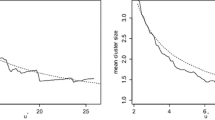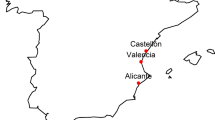Abstract
We propose a parsimonious stochastic model for characterising the distributional and temporal properties of rainfall. The model is based on an integrated Ornstein–Uhlenbeck process driven by the Hougaard Lévy process. We derive properties of this process and propose an extended model which generalises the Ornstein–Uhlenbeck process to the class of continuous-time ARMA processes. The model is illustrated by fitting it to empirical rainfall data on both daily and hourly time scales. It is shown that the model is sufficiently flexible to capture important features of the rainfall process across locations and time scales. Finally, we study an application to the pricing of rainfall derivatives which introduces the market price of risk via the Esscher transform. We first give a result specifying the risk-neutral expectation of a general moving average process. Then we illustrate the pricing method by calculating futures prices based on empirical daily rainfall data, where the rainfall process is specified by our model.









Similar content being viewed by others
Notes
The conditions are as follows: \(a\) and \(b\) have no common zeroes, the roots of \(a\) have multiplicity 1, and \(\text{ Im }(\lambda _i) \in (-\frac{\pi }{\delta },\frac{\pi }{\delta })\).
References
Applebaum, D.: Lévy Processes and Stochastic Calculus, 2nd edn. Cambridge University Press, Cambridge (2009)
Barndorff-Nielsen, O.: Superposition of Ornstein–Uhlenbeck type processes. Theory Probab. Appl. 45(2), 175–194 (2001)
Barndorff-Nielsen, O.E., Shephard, N.: Non-Gaussian Ornstein–Uhlenbeck-based models and some of their uses in financial economics. J. R. Stat. Soc. Ser. B Stat. Methodol. 63(2), 167–241 (2001)
Basse-O’Connor, A., Graversen, S., Pedersen, J.: Stochastic integration on the real line. Theory Probab. Appl. 58(2), 193–215 (2014)
Benth, F., Šaltytė Benth, J.: Modeling and Pricing in Financial Markets for Weather Derivatives, 1st edn. World Scientific Publishing, Singapore (2013)
Brockwell, P.: Lévy-driven CARMA processes. Ann. Inst. Stat. Math. 53(1), 113–124 (2001)
Brockwell, P.: Representations of continuous-time ARMA processes. J. Appl. Probab. 41(2004), 375–382 (2004)
Brockwell, P.J., Lindner, A.: Existence and uniqueness of stationary Lévy-driven CARMA processes. Stoch. Process. Appl. 119(8), 2660–2681 (2009)
Brockwell, P., Lindner, A.: Integration of CARMA processes and spot volatility modelling. J. Time Ser. Anal. 34(2), 156–167 (2013)
Carmona, R., Diko, P.: Pricing precipitation based derivatives. Int. J. Theor. Appl. Financ. 08(07), 959–988 (2005)
Chandler, R.E.: A spectral method for estimating parameters in rainfall models. Bernoulli 3(3), 301–322 (1997)
Chin, E.H.: Modeling daily precipitation occurrence process with Markov Chain. Water Resour. Res. 13(6), 949–956 (1977)
Coe, R., Stern, R.: Fitting models to daily rainfall data. J. Appl. Meteorol. 21(7), 1024–1031 (1982)
Cont, R., Tankov, P.: Financial Modelling with Jump Processes. Chapman & Hall, London (2004)
Cowpertwait, P.S.P.: A generalized point process model for rainfall. Proc. R. Soc. A Math. Phys. Eng. Sci. 447(1929), 23–37 (1994)
Cox, D.R., Isham, V.: A simple spatial-temporal model of rainfall. Proc. R. Soc. A Math. Phys. Eng. Sci. 415(1849), 317–328 (1988)
Dunn, P.K.: Occurrence and quantity of precipitation can be modelled simultaneously. Int. J. Climatol. 24(10), 1231–1239 (2004)
Esche, F., Schweizer, M.: Minimal entropy preserves the Lévy property: how and why. Stoch. Process. Appl. 115(2), 299–327 (2005)
Esscher, F.: On the probability function in the collective theory of risk. Scand. Actuar. J. 15(3), 175–195 (1932)
Frittelli, M.: The minimal entropy martingale measure and the valuation problem in incomplete markets. Math. Financ. 10(1), 39–52 (2000)
Gerber, H., Shiu, E.: Option pricing by Esscher transforms. Trans. Soc. Actuar. 46, 99–191 (1994)
Grigelionis, B.: On the Hougaard subordinated Gaussian Lévy processes. Stat. Probab. Lett. 81(8), 998–1002 (2011)
Härdle, W.K., Cabrera, B.L.: The implied market price of weather risk. Appli. Math. Financ. 19(1), 59–95 (2012)
Jørgensen, B.: The Theory of Dispersion Models. Chapmann & Hall, London (1997)
Katz, R.: Precipitation as a chain-dependent process. J. Appl. Meteorol. 16(7), 671–676 (1977)
Künsch, H.R.: The Jackknife and the bootstrap for general stationary observations. Ann. Stat. 17(3), 1217–1241 (1989)
Lee, M., Whitmore, G.: Stochastic processes directed by randomized time. J. Appl. Probab. 30(2), 302–314 (1993)
Leobacher, G., Ngare, P.: On modelling and pricing rainfall derivatives with seasonality. Appl. Math. Financ. 18(1), 71–91 (2011)
López Cabrera, B., Odening, M., Ritter, M.: Pricing rainfall futures at the CME. J. Bank. Financ. 37(11), 4286–4298 (2013)
Øksendal, B.: Stochastic Differential Equations: An Introduction with Applications, 6th edn. Springer, Berlin (2003)
Onof, C., Chandler, R.E., Kakou, A., Northrop, P., Wheater, H.S., Isham, V.: Rainfall modelling using Poisson-cluster processes: a review of developments. Stoch. Environ. Res. Risk Assess. 14(6), 384–411 (2000)
Politis, D.N., Romano, J.P.: The stationary bootstrap. J. Am. Stat. Assoc. 89(428), 1303–1313 (1994)
Rodriguez-Iturbe, I., Cox, D.R., Isham, V.: Some models for rainfall based on stochastic point processes. Proc. R. Soc. A Math. Phys. Eng. Sci. 410(1839), 269–288 (1987)
Samuel, C.R.: Stochastic rainfall modelling of convective storms in Walnut Gulch, Arizona. Ph.D. thesis, Imperial College London (1999)
UK Meteorological Office: Met Office Integrated Data Archive System (MIDAS) Land and Marine Surface Stations Data (1853-current)’. NCAS British Atmospheric Data Centre. http://catalogue.ceda.ac.uk/uuid/220a65615218d5c9cc9e4785a3234bd0 (2012)
Wilks, D.: Multisite generalization of a daily stochastic precipitation generation model. J. Hydrol. 210(1), 178–191 (1998)
Woolhiser, D.A., Roldán, J.: Stochastic daily precipitation models: 2. A comparison of distributions of amounts. Water Resour. Res. 18(5), 1461–1468 (1982)
Acknowledgments
We thank the Associate Editor and two anonymous referees for constructive suggestions that led to significant improvements of the paper. R. C. Noven gratefully acknowledges financial support from the Grantham Institute for Climate Change, Imperial College London. We thank the UK Meteorological Office and the British Atmospheric Data Centre for providing the data used.
Author information
Authors and Affiliations
Corresponding author
Appendix
Appendix
In the following we present the proofs of our theoretical results.
First we quote a result (Cont and Tankov 2004, Lemma 15.1) which will be used repeatedly in the following:
Lemma 1
Let \(f: [0,T]\rightarrow \mathbb {R}\) be a left-continuous function and \(L(t)\) a Lévy process. Then
where \(\psi (t)\) is the characteristic exponent of \(L\), given by
Characteristic function of \({\varvec{\Delta Y}}\) The characteristic function of \(\Delta Y\) is given by
where
This follows immediately from applying Lemma 1 to the expression given in (12) and noting that because \(\Delta Y\) is stationary we can set \(t_{i-1}=t_0=0\), causing the second integral to vanish.
Proof of Proposition 1 By construction of \(f_\delta \), we have that
and hence by the Fubini theorem, it follows that
similar to the proof of Proposition 8.4 in Benth and Šaltytė Benth (2013).
We now calculate the expectation involving the integrated moving average process \(Y\). To this end, we first split the integrals in the expression for \(Y\) as follows:
By the abstract Bayes formula (see, e.g. Øksendal 2003), for the measure \(Q\) such that \(\mathrm{d}Q/\mathrm{d}P|_{\mathcal {F}_t}=Z(t)\), with \(X\) being \(\mathcal {F}_\tau \)-measurable and \(t<\tau \), we have that
Recall that we are working with the Esscher transform, so we have
Applying the Esscher transform then gives
where we get an unconditional expectation due to the independent increments of \(L\).
We can extend Lemma 1 to complex-valued functions to get
where the term on the RHS equals
and we have that
and so if \(\sup _v a(v)<k\), then the last term is bounded by the exponential moment condition given in (17).
Applying (21) to the terms in \(\mathbf {(A)}\) gives
where the requirement \(\sup _{v \in [t,\tau _2]} \left( |\theta (v)|+\delta |g(\tau _2,v)-g(\tau _1,v)| \right) <k\) ensures that the terms in the above equation are well-defined.
Now we consider the Lévy–Khintchine formula for subordinators, which takes the form
where \(\nu (\cdot )\) is the Lévy measure associated with \(L\). We can analytically continue this formula to complex arguments (Applebaum 2009, p. 338), and so we get that
We note that this expression can also be written as
where \(L_Q(v)\) is now a non-stationary stochastic process with jump measure depending on time, namely
Thus we see that conditioning with respect to the measure \(Q\) has the effect of exponentially tilting the jump measure of \(L\) at time \(v\) according to \(\theta (v)\), so the jumps of \(L\) at times \(v\) will be weighted more or less in the expectation depending on the sign of \(\theta (v)\).
Now defining
we get that
and by similar arguments
Substituting these expressions into (20) then gives the result.
Hougaard process The Hougaard process has Lévy measure given by (Grigelionis 2011)
in terms of the Tweedie parameterisation. We also have that when \(L\) is the Hougaard process, the function \(\psi _\theta \) defined in (22) takes the form
Rights and permissions
About this article
Cite this article
Noven, R.C., Veraart, A.E.D. & Gandy, A. A Lévy-driven rainfall model with applications to futures pricing. AStA Adv Stat Anal 99, 403–432 (2015). https://doi.org/10.1007/s10182-015-0246-8
Received:
Accepted:
Published:
Issue Date:
DOI: https://doi.org/10.1007/s10182-015-0246-8




